On the morning of the day I had decided to go without
using plastic products — or even touching plastic — I opened my eyes and put my
bare feet on the carpet. Which is made of nylon, a type of plastic. I was
roughly 10 seconds into my experiment, and I had already committed a violation.
اضافة اعلان
Since its invention more than a century ago, plastic has crept
into every aspect of our lives. It is hard to go even a few minutes without
touching this durable, lightweight, wildly versatile substance. Plastic has
made possible thousands of modern conveniences, but it has come with downsides,
especially for the environment. Last week, in a 24-hour experiment, I tried to
live without it altogether in an effort to see what plastic stuff we can’t do
without and what we may be able to give up.
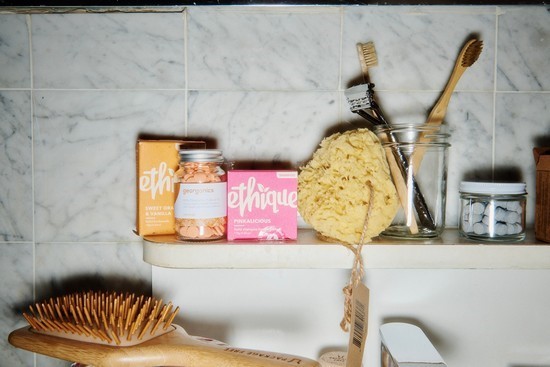 Plastic-free items at
the home of NYT reporter A.J. Jacobs, in New York.
Plastic-free items at
the home of NYT reporter A.J. Jacobs, in New York.
Most mornings I check my iPhone soon after waking up. On the
appointed day, this was not possible, given that, in addition to aluminum,
iron, lithium, gold, and copper, each iPhone contains plastic. In preparation
for the experiment, I had stashed my device in a closet. I quickly found that
not having access to it left me feeling disoriented and bold, as if I were some
sort of intrepid time traveler.
I made my way toward the bathroom, only to stop myself before I
went in.
“Could you open the door for me?” I asked my wife, Julie. “The
doorknob has a plastic coating.”
She opened it for me, letting out a “this is going to be a long
day” sigh.
My morning hygiene routine needed a total revamp, which required
detailed preparations in the days before my experiment. I could not use my
regular toothpaste, toothbrush, shampoo or liquid soap, all of which were
encased in plastic or made of plastic.
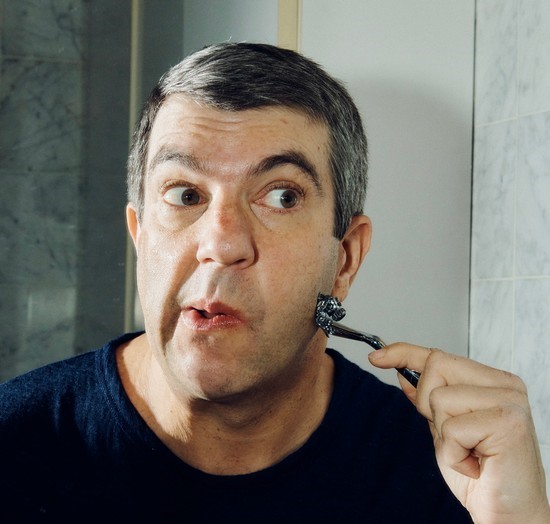 NYT reporter A.J.
Jacobs shaves with his plastic-free razor.
NYT reporter A.J.
Jacobs shaves with his plastic-free razor.
Fortunately, there is a huge industry of plastic-free products
targeted at eco-conscious consumers, and I had bought an array of them, a haul
that included a bamboo toothbrush with bristles made of wild boar hair from
Life Without Plastic. “The bristles are completely sterilized,” Jay Sinha, the
company’s co-owner, assured me when I spoke with him the week before.
Instead of toothpaste, I had a jar of gray charcoal-mint
toothpaste pellets. I popped one in, chewed it, sipped water, and brushed. It
was nice and minty, although the ash-colored spit was unsettling.
I liked my shampoo bar. A shampoo bar is just what it sounds
like: a bar of shampoo. Mine was scented pink grapefruit and vanilla, and
lathered up well. According to shampoo bar advocates, it is also cheaper than
bottled shampoo on a per-wash basis (one bar can last 80 showers). Which is
good, because plastic-free life can be expensive. I also got a zinc and
stainless-steel razor for $84.
Taking a blogger’s advice, I mixed a DIY deodorant out of tea
tree oil and baking soda. It left me smelling a little like a medieval
cathedral, but in a good way. Making your own stuff is another way to avoid
plastic, although it requires another luxury: free time.
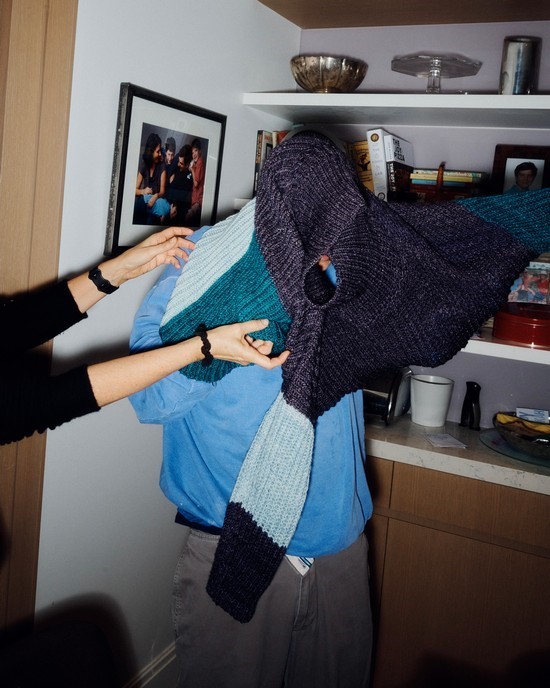 NYT reporter A.J.
Jacobs dons a handmade wool sweater.
NYT reporter A.J.
Jacobs dons a handmade wool sweater.
Before I was done in the bathroom, I had broken the rules a
second time, by using the toilet.
Getting dressed was also a challenge, given that so many
clothing items include plastic. I had ordered a pair of wool pants that
promised to be plastic-free, but they had not arrived. In their stead, I chose
a pair of old Banana Republic chinos.
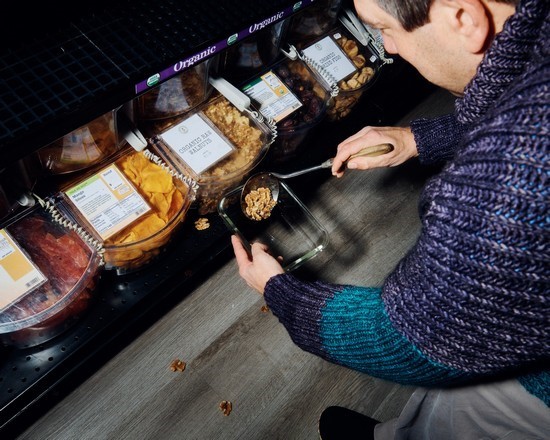 NYT reporter A.J.
Jacobs scoops walnuts into a glass container at a Whole Foods in New York.
NYT reporter A.J.
Jacobs scoops walnuts into a glass container at a Whole Foods in New York.
For my upper body, I lucked out. Our friend Kristen had knitted
my wife a sweater for a birthday present. It had rectangles of blue and purple,
and it was 100 percent merino wool.
“Could I borrow Kristen’s sweater for the day?” I asked Julie.
“You’re going to stretch it out,” Julie said.
“It’s for planet Earth,” I reminded her.
Plastics present and pastThe world produces about 400 million tonnes of plastic waste
each year, according to a UN report. About half is tossed out after a single
use. The report noted that “we have become addicted to single-use plastic
products — with severe environmental, social, economic and health
consequences.”
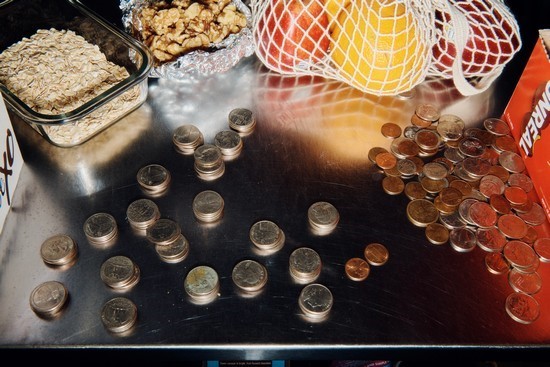 Coins counted out for
groceries by NYT reporter A.J. Jacobs in New York.
Coins counted out for
groceries by NYT reporter A.J. Jacobs in New York.
I am one of the addicts. I did an audit, and I would estimate
that I toss about 800 plastic items in the garbage a year — takeout containers,
pens, cups, Amazon packages with foam inside, and more.
Before my Day of No Plastic, I immersed myself in a number of
no-plastic and zero-waste books, videos, and podcasts. One of the books, “Life without
Plastic: The Practical Step-by-Step Guide to Avoiding Plastic to Keep Your
Family and the Planet Healthy,” by Sinha and Chantal Plamondon, came from
Amazon wrapped in clear plastic, like a slice of American cheese. When I
mentioned this to Sinha, he promised to look into it.
I also called Gabby Salazar, a social scientist who studies what
motivates people to support environmental causes, and asked for her advice as I
headed into my plastic-free day.
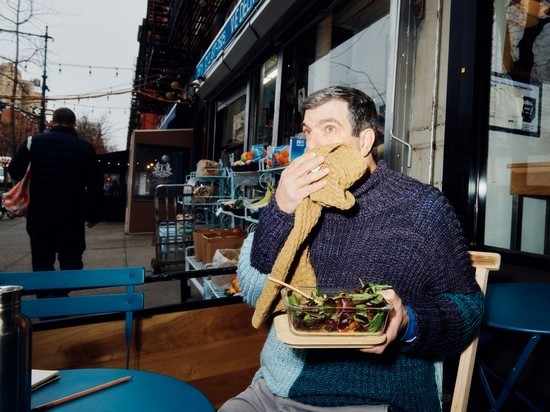 NYT reporter A.J. Jacobs sits on his wooden
chair eating lunch with a bamboo fork.
NYT reporter A.J. Jacobs sits on his wooden
chair eating lunch with a bamboo fork.
“It might be better to start small,” Salazar said. “Start by
creating a single habit — like always carrying a stainless-steel water bottle.
After you’ve got that down, you start another habit, like taking produce bags
to the grocery. You build up gradually. That’s how you make real change.
Otherwise, you’ll just be overwhelmed.”
Plastic manufacturing ramped up for World War II and was crucial
to the war effort, providing nylon parachutes and Plexiglas aircraft windows.
That was followed by a postwar boom, said Susan Freinkel, author of “Plastic: A
Toxic Love Story,” a book on the history and science of plastic. “Plastic went
into things like Formica counters, refrigerator liners, car parts, clothing,
shoes, just all sorts of stuff that was designed to be used for a while,” she
said.
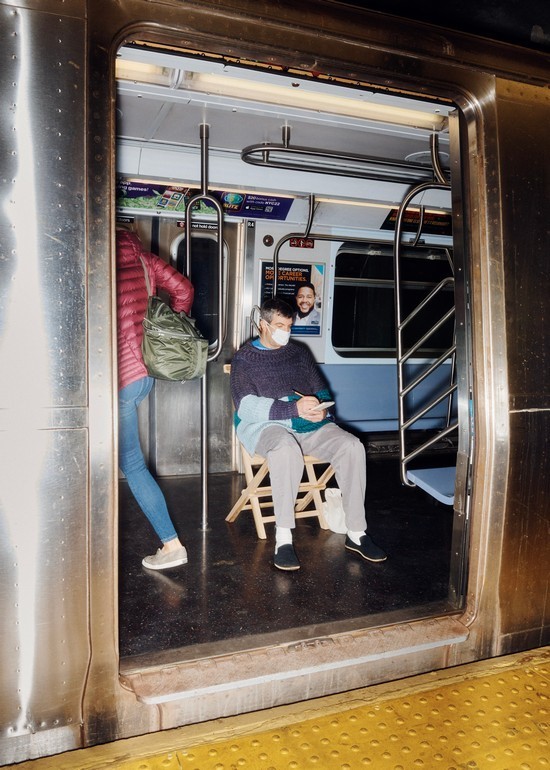 NYT reporter A.J.
Jacobs sits on his wooden chair on the subway in New York..
NYT reporter A.J.
Jacobs sits on his wooden chair on the subway in New York..
Then things took a turn.
“Where we really started to get into trouble is when it started
going into single-use stuff,” Freinkel said. “I call it prefab litter.”
The outpouring of straws, cups, bags, and other ephemera has led
to disastrous consequences for the environment. According to a study by the Pew
Charitable Trusts, more than 11 million tonnes of plastic enter oceans each
year, leaching into the water, disrupting the food chain and choking marine
life.
It is everywhereEarly in my no-plastic day, I started to see the world
differently. Everything looked menacing, like it might be harboring hidden
polymers. The kitchen was particularly fraught. Anything I could use for
cooking was off-limits — the toaster, the oven, the microwave. Even leftovers
were a no-go. My son waved a plastic baggie filled with French toast. “You want
some of this?” Yes, I did.
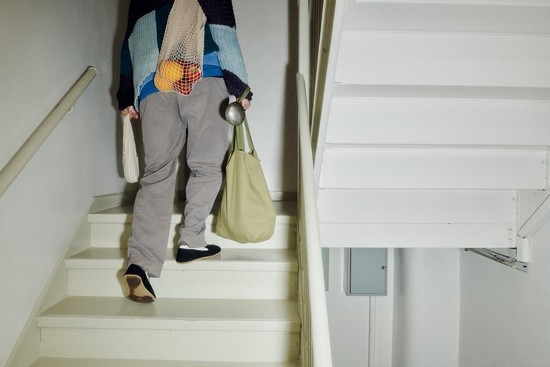 NYT reporter A.J. Jacobs walks up the stairs to avoid
touching the plastic in an elevator in New York, Jan. 5, 2023. It’s all around
us, despite its adverse effects on the planet.
NYT reporter A.J. Jacobs walks up the stairs to avoid
touching the plastic in an elevator in New York, Jan. 5, 2023. It’s all around
us, despite its adverse effects on the planet.
Instead, I decided to go foraging for raw food items.
I left my building using the stairs, rather than the elevator
with its plastic buttons, and walked to a health food store near our apartment
on the Upper West Side of Manhattan.
When I go shopping, I try to remember to take a cloth bag with
me. This time, I had brought along seven bags of varying sizes, all of them
cotton. I also had two glass containers.
At the store, I filled up one of my cotton bags with apples and
oranges. On close inspection, I noticed that the each rind had a sticker with a
code. Another likely violation, but I ignored it.
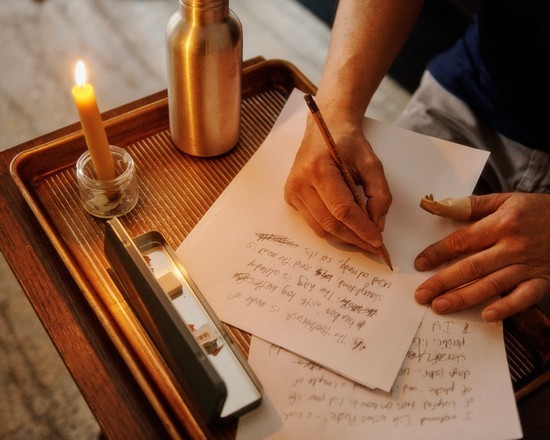 NYT reporter A.J.
Jacobs writes the first draft of the article with a wooden pencil by
candlelight.
NYT reporter A.J.
Jacobs writes the first draft of the article with a wooden pencil by
candlelight.
At the bulk bins, I scooped walnuts and oatmeal into my glass
dishes using a (washed) steel ladle I had brought from home. The bins
themselves were plastic, which I ignored, because I was hungry.
I went to the cashier. At which point it was time to pay. Which
was a problem. Credit cards were out. So was my iPhone’s Apple Pay. Paper money
was another violation: Although US paper currency is made mainly of cotton and
linen, each bill likely contains synthetic fibers, and the higher denominations
have a security thread made of plastic to prevent counterfeiting.
To be safe, I had brought along a cotton sack full of coins.
Yes, a big old sack heavy with quarters, dimes, and pennies — about $60 worth
that I had withdrawn from Citibank and my kids’ piggy banks.
At the checkout counter, I started stacking quarters as quickly
as I could between nervous glances at the customers behind me.
“I’m really sorry this is taking so long,” I said.
“That’s OK,” the cashier said. “I meditate every morning so I
can deal with turmoil like this.”
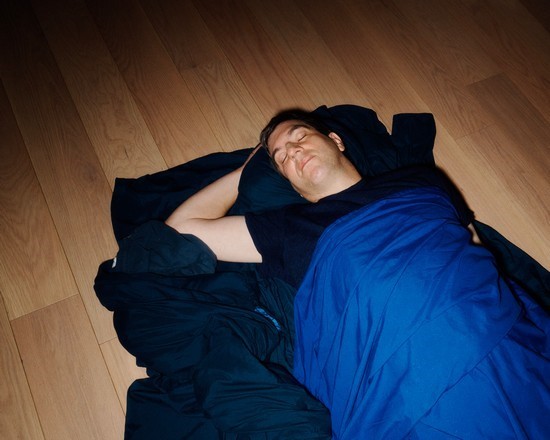 NYT A.J. Jacobs tests
his plastic-free sleeping arrangements.
NYT A.J. Jacobs tests
his plastic-free sleeping arrangements.
He added that he appreciated my commitment to the environment.
It was the first positive feedback I had received. I counted out $19.02 — exact
change! — and went home to eat my breakfast: nuts and oranges on a metal cookie
tray, which I balanced on my lap.
A couple of hours later, in search of a plastic-free lunch, I
walked to Lenwich, a sandwich and salad shop in my neighborhood. I arrived
early in the afternoon, toting my rectangular glass dish and bamboo cutlery.
“Can you make the salad in this glass container?” I asked,
holding it up.
“One minute please,” the man behind the counter said, tersely.
He called over a manager, who said OK. Victory! But the manager
then rejected my follow-up request to use my steel scooper.
After lunch, I headed to Central Park, figuring that this was a
spot in Manhattan where I could relax in a plastic-free environment. I took the
subway there, which scored me more violations, since the trains themselves have
plastic parts and you need a MetroCard or smartphone to get through the
turnstiles.
Walking through Central Park, I spotted dental floss picks, a
black plastic knife, and a plastic bag.
Back home, I recorded some of my impressions. I wrote on paper
with an unpainted cedar pencil from a “Zero Waste Pencil tin set” (regular
pencils contain plastic-filled yellow paint). After a while, I went to get a
drink of water. Which brings up perhaps the most pervasive foe of all, one I
have not even mentioned yet: microplastics. These tiny particles are everywhere
— in the water we drink, the air we breathe, in the oceans. They come from,
among other things, degraded plastic litter.
Are microplastics harmful to us? I talked with several
scientists, and the general answer I got was: We do not know yet. “I think
we’ll have an improved understanding in the next few years,” said Todd Gouin,
an environmental research consultant. But those who are extra-cautious can use
products that promise to filter microplastics from water and air.
I had bought a pitcher by LifeStraw that contains a membrane
microfilter. Of course, the pitcher itself had plastic parts, so I could not
use it on the Big Day. Instead, the night before, I spent some time at the sink
filtering water and filling up Mason jars. Our kitchen looked like it was ready
for the apocalypse.
The water tasted particularly pure, which I am guessing was some
sort of a placebo effect.
I wrote for a while. Then I sat there in my wooden chair.
Phone-less. Internet-less. Julie took some pity on me and offered to play a
game of cards. I shook my head.
“Plastic coating,” I said.
At about 9pm, I took our dog for her nightly walk. I was using a
100 percent cotton leash I bought online. I had ditched the poop bags — even
the sustainable ones I found were made with recycled or plant-based plastic.
Instead, I carried a metal spatula. Thankfully, I did not have to use it.
At 10:30pm, exhausted, I lay down on my makeshift bed — cotton
sheets on the wood floor, since my mattress and pillows are plasticky.
I woke up the next morning glad to have survived my ordeal and
be reunited with my phone — but also with a feeling of defeat.
Ball of confusionI had made 164 violations, by my count. As Salazar had
predicted, I felt overwhelmed. And also uncertain. There was so much that
remained unclear, even after I had been studying this topic for weeks. What
plastic-free items really made a difference, and what is mere green-washing? Is
it a good idea to use boar’s-hair toothbrushes, tea tree deodorant,
microplastic-filtering devices, and paper straws, or does the trouble of using
those things make everyone so bonkers that they actually end up damaging the
cause?
I called Salazar for a pep talk.
“You can drive yourself crazy,” she said. “But it’s not about
perfection, it’s about progress. Believe it or not, individual behavior does
matter. It adds up.
“Remember,” she continued, “it’s not about plastic being the
enemy. It’s about single-use as the enemy. It’s the culture of using something
once and throwing it away.”
I will start with small things, building up habits. I liked the
shampoo bar. And I can take produce bags to the grocery. I might even pack my
steel water bottle and bamboo cutlery for my trips to Lenwich. And from there,
who knows?
And I will proudly wear the “Keep the Sea Plastic Free” T-shirt
that I bought online in the days leading up to the experiment. It’s just 10
percent polyester.
Read more Lifestyle
Jordan News















